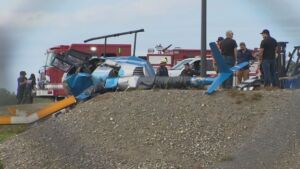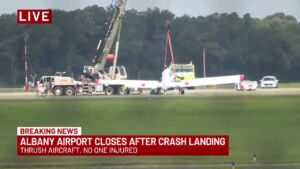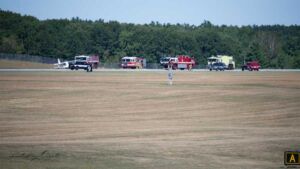Here are your stories for today...
Be safe out there!
Tom
2 injured after helicopter crashes at Skagit Regional Airport in Burlington
by KOMO News Staff
BURLINGTON, Wash. — A helicopter crashed at Skagit Regional Airport in Burlington Monday morning.
Skagit Regional Airport in Burlington Monday morning.
The incident was reported at 10:08 a.m. The helicopter was carrying two people inside. Both passengers sustained injuries and were taken to Skagit Regional Hospital, according to airport officials.
It was an R44 helicopter.
The Robinson R44 is a single-engine, light utility helicopter known for its popularity as a training and recreational aircraft. It is a four-seat helicopter, featuring a two-bladed main rotor and a two-bladed tail rotor.
helicopter known for its popularity as a training and recreational aircraft. It is a four-seat helicopter, featuring a two-bladed main rotor and a two-bladed tail rotor.
Robinson Helicopter Company produces the helicopter and is a common sight in both civilian and commercial aviation.
https://komonews.com/news/local/burlington-helicopter-crash-skagit-regional-airport-two-people-injured-aircraft-aviation-washington-state?photo=1
Pilot uninjured after landing gear failed causing crash landing at Albany airport
By WALB News Team
ALBANY, Ga. (WALB) - Delta flights to and from the Southwest Georgia Regional Airport appear to have resumed after the city of Albany says the airport was closed to all air traffic after an aircraft doing a test run crashed into the runway.
the Southwest Georgia Regional Airport appear to have resumed after the city of Albany says the airport was closed to all air traffic after an aircraft doing a test run crashed into the runway.
On Monday, August 18, an aircraft manufactured by Thrush Aircraft, LLC, an American aircraft manufacturer based in Albany, Georgia, was doing a test run when its landing gear sheared off, causing the aircraft to crash into the Southwest Georgia Regional Airport’s runway.
The only person on board the aircraft at the time of the crash was the pilot. They are uninjured.
First responders, including the Airport Police Department, the Albany Police Department, the Albany Fire Department, and EMS, all responded to this incident.
The city of Albany previously reported that the airport will remain closed to air traffic until the aircraft can be removed from the runway, which will not happen until the National Transportation Safety Board (NTSB) approves the removal.
However, WALB was on scene around noon when Flight DL4172 from Atlanta, Ga. landed at the Southwest Georgia Regional Airport.
According to Delta, afternoon flights DL3965 and DL3659 are expected to depart and arrive on time.
Plane lands at Portsmouth International Airport with its landing gear retracted; FAA investigating
KC Downey - Digital Media Manager
PORTSMOUTH, N.H. —
A small plane landed in Portsmouth on Monday morning with its landing gear retracted, officials told WMUR.
morning with its landing gear retracted, officials told WMUR.
A Scoda Aeronautica, a high-wing light sport aircraft, landed at 9:23 a.m. Officials with Portsmouth International Airport called the landing an “aircraft emergency.”
A runway at the airport was closed for a little more than an hour after the landing.
There were no injuries reported.
There was one person on board the plane, which was not damaged. The runway also was not damaged, officials said.
Federal Aviation Administration officials are investigating the landing.
Because of the incident, an Allegiant flight ended up diverting to Boston to refuel before heading back to Portsmouth International Airport.
https://www.wmur.com/article/portsmouth-new-hampshire-airport-landing-818/65809960
NTSB Prelim: Moyes Liteflite Pty Ltd C Dragonfly
Video Showed The Airplane In A Left Turning Descent Before It Entered A Shallow Right Spiraling Descent
Location: Charlestown, NH Accident Number: ERA25LA265
Date & Time: July 13, 2025, 19:15 Local Registration: N4010E
Aircraft: Moyes Liteflite Pty Ltd C Dragonfly Injuries: 1 Serious
Flight Conducted Under: Part 91: General aviation - Glider tow
On July 13, 2025, about 1915 eastern daylight time, a Moyes Liteflite Model C Dragonfly airplane, N4010E, was substantially damaged when it was involved in an accident near Charleston, New Hampshire. The pilot was seriously injured. The airplane was operated as a Title 14 Code of Federal Regulations Part 91 glider tow flight.
The pilot reported that the accident flight was his fifth tow flight of the day. There were no anomalies noted during preflight inspection or before the takeoff engine runup checks. The airplane departed with about 4-gallons of fuel onboard. After reaching an altitude of 3,500 ft, the glider released and the pilot reduced engine power to idle and entered a routine spiraling descent to land. During the descent, the airplane experienced a total loss of engine power which the pilot did not observe until he advanced the throttle, and the engine did not respond.
A witness at the departure airport recorded a video of the airplane as it descended. The video showed the airplane in a left turning descent before it entered a shallow right spiraling descent. The airplane remained in the right turn until it impacted the ground. The airplane came to rest in an upright position in a grass field about one-half mile from the departure airport.
Postaccident examination of the airplane by an Federal Aviation Administration inspector revealed that the tubular structure of the fuselage exhibited deformation and fractures from impact forces. Flight control continuity was established from the cockpit to all of the flight control surfaces. The engine remained attached to the fuselage and the throttle control cables remained attached and were continuous to the throttle control lever. The fuel tank contained about 2-gallons of fuel and the fuel filter was free of contamination.
The airplane was retained for further examination.
FMI: www.ntsb.gov

Today in History
45 Years ago today: On 19 August 1980 Saudi Arabian Airlines flight 163, a Lockheed L-1011 TriStar, burned out at Riyadh International Airport after an emergency return due to an in-flight fire, killing all 301 occupants.
| Date: | Tuesday 19 August 1980 |
| Time: | 22:08 |
| Type: | Lockheed L-1011 TriStar 200 |
| Owner/operator: | Saudi Arabian Airlines |
| Registration: | HZ-AHK |
| MSN: | 1169 |
| Year of manufacture: | 1979 |
| Total airframe hrs: | 2948 hours |
| Cycles: | 1718 flights |
| Engine model: | Rolls-Royce RB211-524B2-02 |
| Fatalities: | Fatalities: 301 / Occupants: 301 |
| Other fatalities: | 0 |
| Aircraft damage: | Destroyed, written off |
| Category: | Accident |
| Location: | Riyadh International Airport (RUH) - Saudi Arabia |
| Phase: | En route |
| Nature: | Passenger - Scheduled |
| Departure airport: | Riyadh International Airport (RUH/OERY) |
| Destination airport: | Jeddah International Airport (JED/OEJD) |
| Confidence Rating: | Accident investigation report completed and information captured |
Narrative:
Saudi Arabian Airlines flight 163, a Lockheed L-1011 TriStar, burned out at Riyadh International Airport after an emergency return due to an in-flight fire, killing all 301 occupants.
Flight SV163 landed at Riyadh at 16:06 GMT for a scheduled intermediate stop after a flight from Karachi. At 18:08 the aircraft took off for the final leg to Jeddah. Six minutes and 54 seconds after takeoff, while climbing to FL350, visual and aural warnings indicated smoke in the aft cargo compartment C-3. Climbing through FL220 (at 18:20), a return to Riyadh was initiated. About two minutes later smoke was noted in the aft of the cabin, and passengers were panicking. At 18:25:26 the no. 2 engine throttle was stuck. The fire had by then entered the cabin of the TriStar. Because passengers where fighting in the aisles, aft of doors L2 and R2, the captain asked everybody to remain seated (18:27:40). On final approach engine no. 2 was shut down, and the captain told the cabin crew not to evacuate. Flight SV163 landed back at Riyadh runway 01 at 18:36:24 The crew continued to a taxiway and told the tower that they were going to shut the engines down and evacuate. The engines were shut down at 18:42:18. Because no evacuation had been initiated by then, crash, fire and rescue personnel tried to open the doors. At about 19:05 they succeeded in opening door 2R. About three minutes later, the interior was seen to be engulfed in flames. None of the occupants survived the fire.
PROBABLE CAUSE: "The initiation of a fire in the C-3 cargo compartment. The source of the ignition of the fire is undetermined.
Factors contributing to the fatal results of this accident were 1) the failure of the captain to prepare the cabin crew for immediate evacuation upon landing and his failure in not making a maximum stop landing on the runway, with immediate evacuation, 2) the failure of the captain to properly utilize his flight crew throughout the emergency 3) the failure of C/F/R headquarters management personnel to ensure that its personnel had adequate equipment and training to function as required during an emergency."
